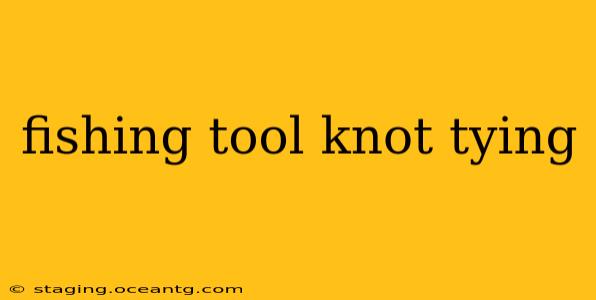Fishing, a pastime enjoyed by millions, hinges on a crucial skill: knot tying. A secure knot is the difference between a successful catch and a frustrating lost fish. This comprehensive guide will delve into essential fishing knots, explaining their uses and techniques, equipping you to confidently tackle any fishing situation. We'll also address some frequently asked questions to make you a knot-tying expert in no time.
Why Are Good Fishing Knots So Important?
Before diving into specific knots, it’s crucial to understand their significance. A poorly tied knot is a weak point in your fishing line, potentially leading to:
- Broken lines: Losing a trophy fish due to a knot failure is incredibly disappointing. Strong, reliable knots prevent this.
- Snagged lures: A weak knot can cause your lure to become snagged, costing you time and potentially damaging your equipment.
- Missed opportunities: A knot that slips can result in missed bites and lost fish.
Mastering knot tying is an investment in your fishing success.
Essential Fishing Knots Every Angler Should Know
Several knots are indispensable for anglers. We'll cover some of the most popular and versatile:
1. Improved Clinch Knot:
This is arguably the most popular knot for attaching lures and hooks to your fishing line. It's relatively easy to learn and exceptionally strong.
How to tie it:
- Pass the line through the eye of the hook.
- Make 5-7 wraps around the standing line.
- Pass the tag end through the loop formed near the hook eye.
- Moisten the knot and gently tighten. Trim the excess tag end.
2. Palomar Knot:
Known for its strength and ease of tying, the Palomar knot is excellent for heavier lines and larger hooks.
How to tie it:
- Double the line and pass it through the eye of the hook.
- Form a loop around the doubled line.
- Pass the hook through the loop.
- Tighten the knot by pulling the standing line. Trim the excess tag end.
3. Uni Knot:
This versatile knot is highly recommended for attaching braided lines to fluorocarbon leaders. It's exceptionally strong and reliable.
How to tie it:
- Pass the line through the eye of the hook or swivel.
- Make 4-5 wraps around the standing line.
- Pass the tag end through the first loop.
- Wet the knot and gently tighten. Trim the excess.
4. Blood Knot:
This knot is used to join two lines of similar diameter. It's crucial for creating leaders or joining different line types effectively.
How to tie it:
- Overlap both lines by 10-12 inches.
- Make 5-7 turns around both lines with each line's tag end.
- Repeat the process on the opposite line.
- Moisten the knot, pull tight, and trim the excess tag ends.
Choosing the Right Knot for the Job
The best knot depends on several factors, including:
- Line type: Different lines (monofilament, fluorocarbon, braided) respond differently to various knots.
- Hook size and type: Larger hooks generally need stronger knots.
- Target species: The strength of your knot should match the fighting power of the fish you are targeting.
How to Improve Your Knot Tying Skills
Practice makes perfect! Regularly practice tying your chosen knots until you can do so quickly and efficiently. Use a variety of line weights and hook sizes to build your proficiency. Consider using a knot-tying tool to assist with precision and consistency.
What are some common mistakes when tying fishing knots?
Incorrect tension: Pulling too hard or too softly during tightening can weaken the knot. Gentle, consistent tightening is key.
Insufficient wraps: Not making enough wraps around the standing line can significantly reduce knot strength.
Improper wetting: Wetting the knot before tightening helps to reduce friction and improve overall knot strength.
What's the strongest fishing knot?
There is no single "strongest" knot, as strength depends on the line type, application, and tying technique. However, the Uni knot and Albright knot are consistently ranked among the strongest.
How often should I check my fishing knots?
Before every cast, inspect your knot for any signs of wear or damage. Restring or retighten as needed. This proactive approach prevents critical failures.
By mastering these knots and techniques, you’ll significantly improve your fishing success. Remember, practice is key to developing the speed and precision necessary for confident knot tying. Tight lines!
